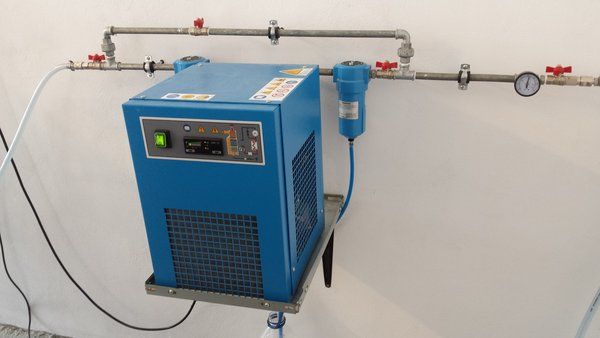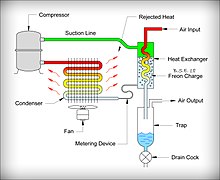Air dryers for air compressors remove moisture from compressed air. They prevent corrosion, improve efficiency, and extend equipment lifespan.
Air dryers are essential for maintaining the quality of compressed air in various applications. Moisture in compressed air can lead to serious issues, such as corrosion and equipment damage. By using an air dryer, users can ensure clean, dry air, which enhances performance and reliability.
Different types of air dryers, including refrigerated and desiccant models, cater to specific needs. Selecting the right air dryer optimizes efficiency and prolongs the life of your compressor and tools. Understanding the benefits and functions of these devices is crucial for anyone relying on compressed air systems. Investing in an air dryer is a smart choice for both safety and productivity.
The Importance Of Air Dryers In Compressed Air Systems
Air dryers play a crucial role in maintaining the efficiency of compressed air systems. They remove moisture from the air, ensuring clean, dry air for various applications. This is vital for industrial processes, tools, and equipment.
Role Of Air Dryers
Air dryers serve several important functions:
- Moisture Removal: They eliminate water vapor in the compressed air.
- Prevent Corrosion: Dry air reduces the risk of rust in machinery.
- Improve Quality: Ensures the air meets quality standards for various tasks.
- Extend Equipment Life: Reduces wear and tear on pneumatic tools.
Consequences Of Moisture In Air Compressors
Moisture can lead to serious issues in compressed air systems:
- Equipment Damage: Water can cause rust and corrosion.
- Reduced Efficiency: Moisture affects the performance of tools.
- Product Contamination: Wet air can compromise product integrity.
- Increased Maintenance Costs: More repairs due to moisture-related issues.
Understanding these consequences highlights the need for air dryers. Implementing them can save costs and improve system efficiency.

Credit: www.air-compressor-guide.com
Types Of Air Dryers For Air Compressors
Choosing the right air dryer for your air compressor is crucial. Different types offer unique benefits. Understanding these types helps make an informed decision.
Refrigerated Air Dryers
Refrigerated air dryers cool the compressed air. This process condenses moisture. The moisture then drains away, leaving dry air.
- Works well for general applications.
- Cost-effective and energy-efficient.
- Simple maintenance requirements.
These dryers typically operate at temperatures between 33°F and 50°F. They are ideal for industries with moderate humidity levels.
Desiccant Air Dryers
Desiccant air dryers use materials to absorb moisture. They are perfect for applications needing very dry air.
- Provide low dew points.
- Used in critical applications like food and pharmaceuticals.
- Higher energy consumption compared to refrigerated dryers.
These dryers regenerate by heating or using compressed air. They can achieve dew points as low as -40°F.
Membrane Air Dryers
Membrane air dryers separate moisture from air using a membrane. The process is efficient and requires no moving parts.
- Compact and lightweight design.
- Easy to install and operate.
- Ideal for small-scale applications.
They work well in low-flow environments. Membrane dryers are effective in removing moisture without additional energy costs.
Selecting The Right Air Dryer
Choosing the right air dryer for your air compressor is crucial. The right unit enhances efficiency. It also protects your tools and extends their lifespan.
Assessing Air Quality Requirements
Understand your air quality needs. Different applications have different requirements. Here are some common air quality standards:
- General Purpose: Suitable for basic applications.
- Precision Tools: Requires cleaner, drier air.
- Food and Beverage: Must meet strict hygiene standards.
Identify the contaminants you want to remove:
- Moisture
- Oil
- Dust
Sizing The Air Dryer
Proper sizing ensures optimal performance. An undersized dryer won’t handle the airflow. An oversized dryer may waste energy.
Consider the following factors:
| Factor | Details |
|---|---|
| Flow Rate | Measure in CFM (Cubic Feet per Minute). |
| Pressure Drop | Ensure minimal loss in system pressure. |
| Temperature | Account for ambient and inlet air temperature. |
Compatibility With Air Compressor
Ensure the air dryer matches your compressor. Check for compatibility in:
- Type of air compressor (reciprocating, rotary screw, etc.)
- Operating pressure range
- Connection sizes and types
Match the dryer’s specifications with your compressor’s. This alignment maximizes efficiency and performance.
Installation Best Practices
Installing an air dryer for your air compressor is crucial. Proper installation ensures efficiency and longevity. Follow these best practices to achieve optimal performance.
Proper Location And Setup
Choosing the right location for your air dryer is essential. Consider the following factors:
- Accessibility: Place the dryer where it’s easy to reach.
- Proximity to the Compressor: Keep it close to minimize pressure loss.
- Stable Surface: Ensure it’s on a flat, solid surface.
Use the following steps for setup:
- Turn off the air compressor.
- Connect the dryer to the compressor outlet.
- Secure all connections to prevent leaks.
- Ensure the drainage line is directed to a proper location.
Ensuring Adequate Ventilation
Proper ventilation is key to the air dryer’s efficiency. Here’s what to consider:
- Airflow: Allow free airflow around the unit.
- Temperature: Keep the area cool to avoid overheating.
- Humidity Control: Ensure humidity levels are manageable.
Follow these tips for optimal ventilation:
| Tip | Description |
|---|---|
| Clear Surroundings | Remove any obstructions around the dryer. |
| Use Fans | Install fans to enhance airflow if needed. |
| Regular Checks | Inspect the area for dust and debris. |
Proper installation and ventilation enhance the dryer’s lifespan. Follow these practices for effective use.
Maintenance For Optimal Performance
Keeping your air dryer in top shape ensures optimal performance. Regular maintenance helps prevent problems and extends the dryer’s lifespan. Follow these steps to maintain your air dryer effectively.
Routine Checks And Cleaning
Regular checks help identify issues early. Follow this simple routine:
- Inspect air filters every month.
- Clean or replace filters as needed.
- Check for leaks in the system.
- Inspect hoses and connections for wear.
Cleaning the unit is essential. Dust and debris can cause blockages. Use a soft cloth to wipe the exterior. For interior cleaning, follow the manufacturer’s instructions.
Replacing Desiccant Material
Desiccant material absorbs moisture. It can become saturated over time. Replace it as follows:
- Turn off the air compressor.
- Open the desiccant chamber.
- Remove the old material carefully.
- Fill with new desiccant up to the recommended level.
- Secure the chamber and restart the system.
Check the desiccant monthly. A change in color indicates it’s time for a replacement.
Troubleshooting Common Issues
Address common problems quickly. Here are a few issues and solutions:
| Issue | Possible Cause | Solution |
|---|---|---|
| Excess moisture | Saturated desiccant | Replace desiccant material |
| No airflow | Blocked filters | Clean or replace filters |
| Strange noises | Loose components | Tighten or replace loose parts |
| Frequent cycling | Improper settings | Check and adjust settings |
Address these issues promptly. Regular maintenance can prevent major breakdowns.

Credit: airvacinc.com
Energy Efficiency And Cost Savings
Air dryers for air compressors are essential for enhancing energy efficiency and saving costs. These devices ensure optimal performance while minimizing energy waste. Understanding how they work helps businesses save money.
Reducing Energy Consumption
Air dryers significantly cut down energy usage. They remove moisture from compressed air, which prevents unnecessary energy drain. Here are some key points:
- Less Energy Loss: Dry air needs less energy to compress.
- Lower Operating Temperatures: Reduced heat means less cooling energy required.
- Improved Efficiency: Efficient systems lead to lower energy bills.
Effective air dryers can lead to substantial energy savings. Businesses notice lower monthly utility costs.
Long-term Financial Benefits
Investing in air dryers brings long-term financial advantages. Here’s how:
| Benefits | Estimated Savings |
|---|---|
| Reduced Energy Bills | Up to 30% |
| Lower Maintenance Costs | 20% savings over time |
| Increased Equipment Lifespan | 5 years longer |
Many businesses experience these financial benefits:
- Lower energy consumption cuts monthly bills.
- Fewer maintenance issues save repair costs.
- Longer equipment life reduces replacement frequency.
Choosing efficient air dryers proves beneficial for your budget.
Innovations In Air Dryer Technology
Air dryer technology is evolving rapidly. New innovations make air dryers more efficient and effective. These advancements help industries reduce costs and improve performance.
Advancements In Energy Efficiency
Energy efficiency is a key focus in air dryer development. New models use less power while delivering better performance. This leads to significant cost savings.
- Variable speed motors adjust to demand.
- Heat recovery systems reuse waste heat.
- Advanced insulation reduces energy loss.
| Feature | Benefit |
|---|---|
| Variable Speed Motors | Reduces energy consumption. |
| Heat Recovery | Improves overall efficiency. |
| Advanced Insulation | Minimizes heat loss. |
These features help businesses lower their energy bills. Improved energy efficiency also supports environmental goals.
Smart Monitoring Systems
Smart monitoring systems are changing air dryer operations. These systems provide real-time data on performance. Users can track efficiency and detect issues early.
- Remote monitoring via mobile apps.
- Alerts for maintenance needs.
- Data analytics for performance insights.
Smart systems enhance reliability and reduce downtime. They allow for proactive maintenance, which saves money and time. Businesses can optimize air dryer performance easily.
Case Studies: Success Stories And Lessons Learned
Examining real-world examples reveals the benefits of air dryers for air compressors. Companies have transformed operations by integrating these systems. Let’s explore a few case studies that highlight their impact.
Industrial Applications
Many industries rely on air dryers to enhance performance. Here are some notable applications:
- Manufacturing: Reduced moisture improves equipment lifespan.
- Automotive: Cleaner air leads to better paint jobs.
- Food Processing: Ensures safety and quality of products.
Each sector benefits from dry air. Companies report fewer breakdowns and increased efficiency.
Impact On Business Operations
Implementing air dryers improves overall business performance. Here are key impacts:
| Business Aspect | Before Air Dryers | After Air Dryers |
|---|---|---|
| Equipment Downtime | High | Low |
| Product Quality | Inconsistent | Consistent |
| Maintenance Costs | High | Reduced |
Businesses see significant cost savings. Employees report higher job satisfaction. These changes lead to improved profitability.
Success stories highlight the importance of air dryers. They ensure air compressors operate effectively. Investing in these systems yields long-term benefits.

Credit: eatoncompressor.com
Frequently Asked Questions
What Are Air Dryers For Air Compressors?
Air dryers for air compressors are essential devices that remove moisture from compressed air. Moisture can damage equipment and affect performance. By using an air dryer, you ensure clean, dry air is delivered for various applications. This helps extend the lifespan of tools and enhances operational efficiency.
Why Do You Need An Air Dryer?
An air dryer is vital for preventing moisture buildup in compressed air systems. Moisture can lead to rust, corrosion, and operational issues. By eliminating water vapor, you protect your equipment and improve air quality. This is especially crucial in industries requiring high-quality air.
How Do Air Dryers Work?
Air dryers use various methods to remove moisture from compressed air. Common types include desiccant dryers and refrigerated dryers. Desiccant dryers absorb moisture, while refrigerated dryers cool air to condense water vapor. Both methods effectively provide dry air for optimal performance in applications.
What Types Of Air Dryers Exist?
There are several types of air dryers, including refrigerated, desiccant, and membrane dryers. Refrigerated dryers are cost-effective and efficient for most applications. Desiccant dryers offer superior moisture removal in critical environments. Membrane dryers are compact and ideal for small-scale operations.
Conclusion
Choosing the right air dryer for your air compressor is crucial for optimal performance. It prevents moisture-related issues and extends equipment lifespan. Investing in a quality air dryer enhances efficiency and productivity. Make informed decisions based on your specific needs.
Quality air dryers are essential for maintaining a reliable compressed air system.
